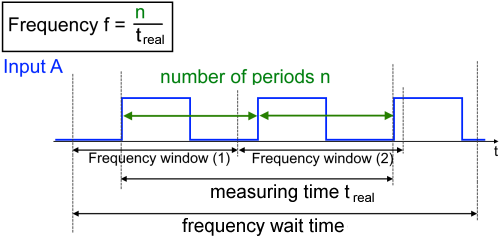Frequency measurement
In addition to the counter value the frequency value can also be calculated and output. The following limit values apply to the determination of measured values:
Measured value | Measured value limit | Comment | |
|---|---|---|---|
lower | top | ||
Frequency value | 0.095 Hz | 5 MHz | with 4-fold evaluation |
0.095 Hz | 1 MHz | with 4-fold evaluation | |
0.095 Hz | 100 kHz | with 4-fold evaluation | |
Sequence of frequency measurement (frequency value)
The frequency is calculated from the number of increments or position value changes within a time interval. The result is output via the process data in index 0x60n0:13 "Frequency value".
Frequency = number of periods / time interval | |
|---|---|
Number of periods | The number of complete periods on track A within the timeframe (0x80n0:11) is measured. Counting starts with the first rising edge within the timeframe (index 0x80n0:11 "Frequency window"). |
Time interval | The time measurement starts with the first rising edge on track A within the "Frequency window" and ends with the last falling edge within the "Frequency window". The time is measured with a resolution of 10 ns. Special case: |
 Fig.167: Frequency measurement - "Frequency value"
Fig.167: Frequency measurement - "Frequency value"- The frequency window is selected in index 0x80n0:11 "Frequency window". The default value is 10 ms.
Follow the instructions below to select the correct timeframe. - "Frequency scaling" (index 0x80n0:13) indicates the resolution of the output frequency. The default value is 0.01 Hz. The frequency can also be output in the unit 1 Hz (set 0x80n0:13 "Frequency scaling" to 1dec). If other resolutions are required, the conversion can be done via 0x80n0:1D "Frequency numerator".
- The calculated frequency value is output in the process data via "Frequency value" (index 0x60n0:13).
- The calculation is carried out acyclically and without reference to the distributed clock system and is therefore independent of the operation mode.
- Locking the counter value via the gate, a C-reset or external reset has no effect on the frequency calculation.
Correct selection of the frequency window:
In delivery state the frequency window of the frequency measurement is set to 10 ms.
The accuracy and size of the determined frequency depends on the size of the timeframe (0x80n0:11 "Frequency window"), which must be selected to match the application. The minimum value to be entered here is twice the period value of the smallest measured frequency.

At constant speeds, select a larger timeframe so that the best possible averaging can take place.
In situations where frequent positive or negative accelerations are encountered, select a smaller timeframe in order to be able to respond more quickly to changing position values. Alternatively, period value measurement can be used for situations with variable speeds.
Special case: frequency measurement
If no full period is detected within the "Frequency window" (see diagram (1) below), another time Frequency window is started in order to record at least one full period (see diagram (2) below). This happens until the maximum waiting time (0x80n0:17 "Frequency wait time") has elapsed. Until then the last valid value is output in index 0x60n0:13 "Frequency value".
If no full period is detected within the waiting time, the measurement is discarded and the output in index 0x60n0:13 "Frequency value" is set to "0".
 Fig.168: Frequency measurement outside the frequency window with waiting time
Fig.168: Frequency measurement outside the frequency window with waiting time | Difference frequency and period value measurement The period value is recalculated for each cycle and output in the process data. The frequency measurement always averages the measured periods over a timeframe. The "Period value" is therefore a current value, the "Frequency value" is an averaged value. |